|
Home >>
Destination Guide India > Udaipur
DESTINATION
GUIDE INDIA - UDAIPUR
ABOUT UDAIPUR CITY
A desert kingdom tucked away in the midst
of hills, an impregnable citadel, an impressive royal lineage
stretching back 26 generations, a do or die attitude and a
fierce sense of independence characterise Udaipur. Unlike its
desert counterparts in Rajasthan, Udaipur is situated in the
forested, hilly region of Aravalli Ranges in complete contrast
to the arid deserts of Marwar in the northwest.
Udaipur - dream
destination in the desert, whose sagas of great valour and
stories of high romance add colour and character to a history
as proud and unrelenting as it is long. The kingdom of Mewar
was ruled by the Sisodia dynasty for over 1200 years from
Chittorgarh before Maharana Udai Singh II founded Udaipur in
1568 following the final sacking of their hill fortress. In
sharp contrast to its spartan and martial persona are lakes,
hills, temples, gardens and fairy-tale palaces that make
Udaipur the most romantic and enchanting place in Rajasthan.
Apart from Udaipur's own splendours, there are several other
places to visit in its vicinity – Jaisamand Lake, the fort of
Kumbhalgarh and the temples at Ranakpur, Eklingji, Nagda,
Kankroli and Nathdwara.
TOURIST
ATTRACTIONS - UDAIPUR CITY
Arsi Vilas
Arsi Vilas is an exclusive island located just behind Jag
Niwas. It was built by Maharana Arsi Singh so he could watch
the sunset from the middle of the lake. It has a lower
platform at the back, which serves the purpose of a helipad
when required.
Lake Pichola
This lake is the centre-piece around which Udaipur revolves.
It started off as a small pond built by a banjara, who dammed
up the waters of a mountain stream by building a dyke.
Maharana Udai Singh extended this pond, creating the exquisite
Lake Pichola.
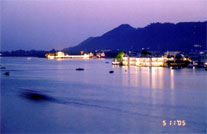 The lake lies to the immediate west of the ridge on which the
City Palace of Udaipur stands. Maharana Udai Singh built a
masonry dam, known as Badi Pol, and the lake is now 4 km long
and 3 km wide. The lake is fairly shallow and can actually dry
up in severe droughts. One day's heavy rain is sufficient to
fill the lake for a year. Amusingly, the water of the lake
belongs to the Government of India whilst the land under water
belongs to the royal family. A few crocodiles are believed to
live in the more remote parts of the lake near uninhabited
sections of the shore. Late in the eighteenth century the
traveller Louis Rousselet wrote this about the crocodiles
after a sojourn in a punt on the lake: The crocodiles found
here as in other inland lakes of India, is a formidable
animal. It attains a great size, and the people who inhabit
the shores of the lake occasionally fall victim to its savage
attacks........Since the English Residency has been
established at Oudeypoor, and the Rana, overcoming the
ridiculous religious prejudices which protect these reptiles,
has allowed Europeans to hunt them down, these formidable
animals have abandoned the neighbourhood of the town, and have
taken refuge on the opposite banks. Pitilessly pursued into
their retreats, they have become very wary. As soon as a boat
appears upon the lake, they dive to the bottom, and, on rising
again, only show the tips of their muzzles above the surface.
The lake lies to the immediate west of the ridge on which the
City Palace of Udaipur stands. Maharana Udai Singh built a
masonry dam, known as Badi Pol, and the lake is now 4 km long
and 3 km wide. The lake is fairly shallow and can actually dry
up in severe droughts. One day's heavy rain is sufficient to
fill the lake for a year. Amusingly, the water of the lake
belongs to the Government of India whilst the land under water
belongs to the royal family. A few crocodiles are believed to
live in the more remote parts of the lake near uninhabited
sections of the shore. Late in the eighteenth century the
traveller Louis Rousselet wrote this about the crocodiles
after a sojourn in a punt on the lake: The crocodiles found
here as in other inland lakes of India, is a formidable
animal. It attains a great size, and the people who inhabit
the shores of the lake occasionally fall victim to its savage
attacks........Since the English Residency has been
established at Oudeypoor, and the Rana, overcoming the
ridiculous religious prejudices which protect these reptiles,
has allowed Europeans to hunt them down, these formidable
animals have abandoned the neighbourhood of the town, and have
taken refuge on the opposite banks. Pitilessly pursued into
their retreats, they have become very wary. As soon as a boat
appears upon the lake, they dive to the bottom, and, on rising
again, only show the tips of their muzzles above the surface.
Pratap Smarak
A
statue of the legendary Rajput warrior Maharana Pratap, who
frequently defied the Mughals, is situated atop Moti Magri
overlooking Fateh Sagar. The way to the top passes through
elegant gardens, including a rock garden in the distinctive
Japanese style. The park is open to the public from 9 am to 6
pm.
Shilpgram
Three km west of Fateh Sagar is an interesting place called
Shilpgram, a crafts village with traditional houses from four
states-Rajasthan, Gujarat, Goa and Maharashtra. Daily
demonstrati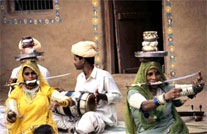 ons
by musicians, dancers or artisans from various states are held
here. Camel or horse rides are available here. It's open daily
from 9 am to 6 pm. The open air Shilpi restaurant next to the
site serves snacks and good Indian and Chinese food. It also
has a swimming pool, open from 11 am to 4 pm. There's no
public transport to Shilpgram, so you'll have to take an
auto-rickshaw or taxi, or you'll have to rent a bicycle. Ahar
Museum ons
by musicians, dancers or artisans from various states are held
here. Camel or horse rides are available here. It's open daily
from 9 am to 6 pm. The open air Shilpi restaurant next to the
site serves snacks and good Indian and Chinese food. It also
has a swimming pool, open from 11 am to 4 pm. There's no
public transport to Shilpgram, so you'll have to take an
auto-rickshaw or taxi, or you'll have to rent a bicycle. Ahar
Museum
Three km east of Udaipur are the remains of an ancient city.
Here, you'll find a small museum housing old earthen pottery,
sculptures and other archaeological finds. The museum is open
daily, except Friday, from 9.30 am to 4.30 pm and entry is
free. Nearby are clusters of Cenotaphs of the maharanas of
Mewar.
The Durbar Hall
India's most impressive, with a sumptuous interior boasting
some of the largest chandeliers in the country. In 1909
Maharana Fateh Singh invited Lord Minto, the then viceroy of
India, to lay the foundation stone of the Durbar Hall. Also
called Minto Hall in his honour, the majestic hall once hosted
formal court gatherings, state banquets and royal weddings.
Numerous old paintings, weapons and grand portraits of former
maharanas of Mewar adorn the walls of this hall. The top floor
of this high ceiling hall, where the crystal collection is now
housed, was the viewing gallery, from where the ladies of the
palace, used to watch in veiled seclusion, the special
functions happening in the Durbar Hall below. Today
painstakingly restored, the size, splendour and capacity of
this hall makes it an ideal venue for hosting special
functions such as conferences or social gatherings.
City Palace Complex and Museums
The gigantic City Palace, towering over the Pichola Lake, is
the largest palace complex in Rajasthan. It extends a
considerable distance along the east bank of the lake. South
of the palace, a pleasant garden runs down to the shore. The
original structure was built in the sixteenth century.
Thereafter, each successive generation of rulers in Udaipur
made its architectural mark on the City Palace complex. By the
end of the nineteenth century the Maharana's Palace was a city
in itself, with storehouses, stables, wells and farms within
it's walls.
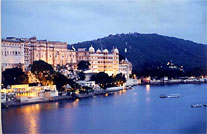 Inspite of being a conglomeration of buildings added by
various rulers, the palace complex manages to retain a
surprising integrity of design. The palace has numerous
balconies, towers and cupolas and there are stunning views
over the lake and the city from the upper terraces. The main
part of the palace has now been preserved as a museum. It has
a large and varied collection of artifacts. The museum
includes the Bari Mahal, which has a lovely central garden.
The Mor Chowk with it's beautiful mosaics of peacocks; the
Manak Mahal with it's collection of glass and porcelain
figures and the Krishna Vilas with it's fine collection of
miniatures are a treat not to be missed. The Zenana Mahal (The
women's private living quarters in a palace) also has a
collection of paintings. If one wants to see examples of
beautiful mirror-work then a visit to the Moti Mahal is a
must. The Chini Mahal is covered in beautiful oriental tiles.
Inspite of being a conglomeration of buildings added by
various rulers, the palace complex manages to retain a
surprising integrity of design. The palace has numerous
balconies, towers and cupolas and there are stunning views
over the lake and the city from the upper terraces. The main
part of the palace has now been preserved as a museum. It has
a large and varied collection of artifacts. The museum
includes the Bari Mahal, which has a lovely central garden.
The Mor Chowk with it's beautiful mosaics of peacocks; the
Manak Mahal with it's collection of glass and porcelain
figures and the Krishna Vilas with it's fine collection of
miniatures are a treat not to be missed. The Zenana Mahal (The
women's private living quarters in a palace) also has a
collection of paintings. If one wants to see examples of
beautiful mirror-work then a visit to the Moti Mahal is a
must. The Chini Mahal is covered in beautiful oriental tiles.
Crystal Gallery
The staggering collection of crystal which is housed in what
was earlier the ladies viewing gallery, was ordered by
Maharana Sajjan Singh in 1877. At that time the Birmingham
based company F & C Osler had a showroom in Calcutta and it
was from here that Maharana Sajjan Singh got his inspiration.
He however died before the shipment could arrive from England.
Much of the crystal remained packed in cases and it was only
in 1994 that it was arranged and opened for public display in
its entirety. The variety of crystal objet d'art includes
fountains, vases, crockery and furniture. What is amazing
about this collection is the ethnicity of the designs. There
are objects in crystal that are distinctly Indian in
conception like the lotas or drinking water vessels and
chuskies or small decanters. Alongside this fascinating range
of crystal are exhibited silver beds, chairs and brocade and
velvet seating.
Fateh Sagar
North of Pichola Lake, this water body is overlooked by a
number of hills and parks. It was originally built in 1678 by
Maharana Jai Singh, but reconstructed by Maharana Fateh Singh
after heavy rains destroyed the dam. A pleasant drive winds
along the east bank and in the middle is Nehru Park, a popular
garden island with a cafe shaped like a boat. You can get
there by boat from near the bottom of Moti Magri. Paddle boats
are available.
Jagdish Temple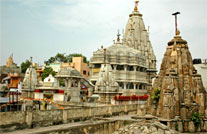
This exquisite Indo-Aryan temple is located north of the
entrance to the City Palace. Maharani Jag Singh built it in
1651. A black stone image of Vishnu as Jagannath, Lord of the
Universe is installed there. A shrine in the front of the
temple has a brass image of the Garuda, a mythological bird
.The steps upto the temple are flanked by elephants.
Jagmandir Palace
An
island palace, its construction was begun by Maharana Karan
Singh, but it takes it's name from Maharana Jagat Singh
(1628-1652) who added to it a zenana (women's quarters) and
named the island Jag Mandir in honour of himself. Made of the
finest yellow sandstone inlaid with marble, it has been
dedicated to Lord Jagannath, the Lord of the Universe. The
place is available for holding various social functions such
as parties and receptions and even marriages! In fact a lot of
westerners come to get married at this place.
Kumbhalgarh Fort
This is the most important fort in the Mewar region after
Chittorgarh. It's an isolated and fascinating place 84 km from
Udaipur, built by Maharana Kumbha in the 15th century. It's
worth taking a leisurely walk in the large compound, which has
some interesting ruins and is very peaceful. The fort is open
daily and entry is free.
Eklingji Temple
Dedicated to the patron deity of the Marwar clan, the Eklingji
Temple still holds a significant place in the hearts of the
Rajasthanis. The original structure of the temple was built in
the 8th century though the present structure was built much
later. Standing at the banks of the Indersagar Lake, the
Eklingji Temple exude a purity that cleanses heart and soul.
Lake Palace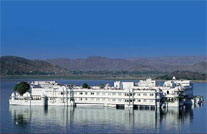
Occupying an island in the midst of Lake Pichola, the Lake
Palace appears to emerge straight from under the water. Today,
the palace has been converted into a heritage hotel and
welcomes guests with a warmth that penetrates deep down the
heart. The royal treatment accorded is akin to those that were
given to the Maharajas of yesteryears.
HOW TO REACH
»
Air : The city has domestic airport, which is service by
majority of airlines. Regular flights connect the city with
key Indian cities like Delhi, Mumbai and so on.
» By Train: The city is conveniently
connected with important destinations of Rajasthan and
neighbouring states like: Gujarat, Madhya Pradesh, Maharashtra
by extensive road network.
» By Road: The city is conveniently
connected with important destinations of Rajasthan and
neighbouring states like: Gujarat, Madhya Pradesh, Maharashtra
by extensive road network. |
![]()